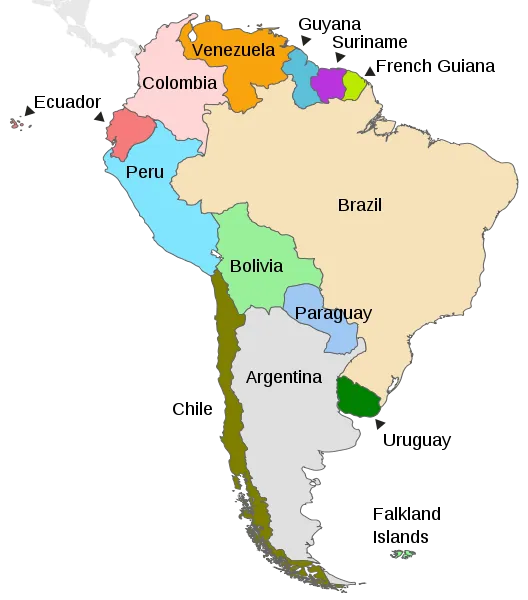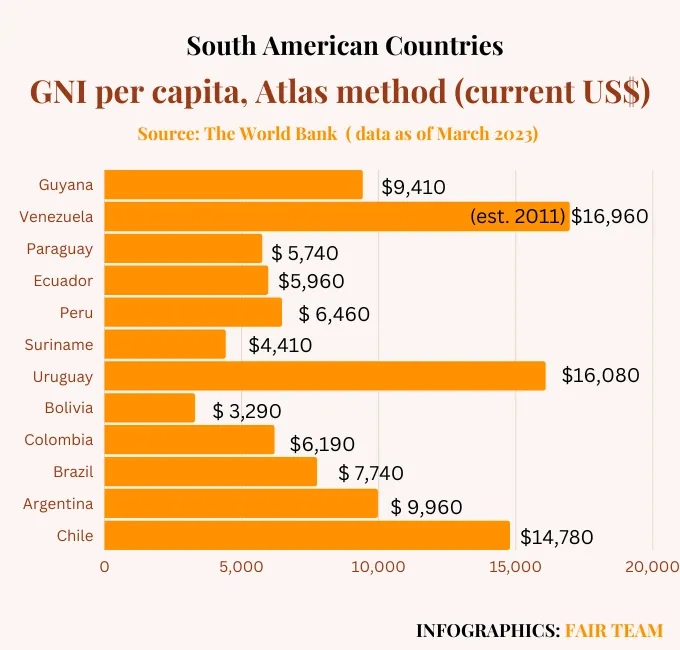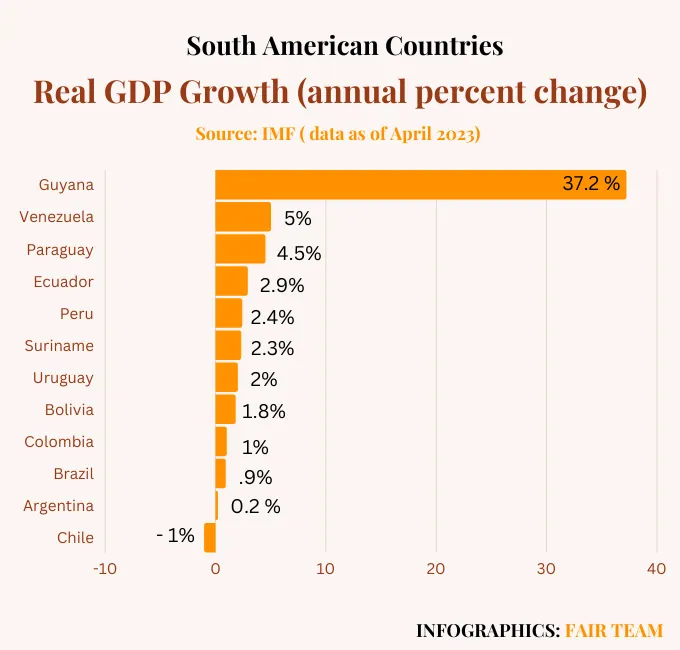South America is a continent known for its rich culture, diverse landscape, and vast resources. It is also home to some of the wealthiest countries in the world, with strong economies and high GDP per capita. The top 10 richest South American countries in terms of GDP per capita are Guyana, Uruguay, Chile, Argentina, Brazil, Peru, Ecuador, Colombia, Paraguay, and Suriname. In addition to GDP per capita, we will be exploring other ranking criteria such as GDP, GNI, and the Human Development Index to provide you with a holistic understanding of the richest countries in South America.
List of the Richest South American Countries [GDP Per Capita]

GDP per capita is a measure of a country’s economic output per person. This method ranks countries based on the average income of their citizens. Countries with high GDP per capita are considered more prosperous than those with lower values. This method is commonly used to compare living standards across countries.
Guyana, The Richest South American Country
With a GDP per capita of $20,540, Guyana is the richest country in South America. The country’s economy is largely dependent on exports, particularly gold, diamonds, and oil. Guyana has made significant progress in reducing poverty and improving infrastructure, but it still faces challenges in terms of political stability and economic diversification.
Uruguay
Uruguay has a GDP per capita of $21,680, making it the second-wealthiest country in South America. The country’s economy is diversified, with a strong focus on services such as tourism, finance, and software development. Uruguay has a stable political environment and is known for its social welfare programs, making it a desirable location for businesses and investors.
[If you’re considering relocating to Uruguay, you may want to explore the options available through the уругвай иммиграция program, which offers pathways for immigration and residency in this economically prosperous nation. Investigating further, you’ll discover that Uruguay’s stable economy and high standard of living make it an appealing destination for those seeking new opportunities.]
Chile
With a GDP per capita of $17,830, Chile is the third wealthiest country in South America. Its economy is largely dependent on exports, particularly copper, fruit, and wine. The country has a strong market-oriented economy with a focus on free trade, making it an attractive destination for foreign investment.
Argentina
With a GDP per capita of $13,710, Argentina is the fourth-richest country in South America. The country has a diverse economy with a focus on agriculture, manufacturing, and services. However, Argentina has been struggling with inflation and a difficult business environment in recent years, which has hindered its economic growth.
Brazil, The Fifth-Richest South American Country
Brazil is the largest economy in South America and the fifth-richest country in terms of GDP per capita, with a figure of $9,670. The country’s economy is diverse, with a strong focus on agriculture, manufacturing, and services. Brazil has a large population and a growing middle class, making it an attractive market for foreign companies.
Peru
With a GDP per capita of $7,770, Peru is the sixth-richest country in South America. The country’s economy is largely dependent on exports, particularly minerals such as copper, gold, and silver. Peru has a stable political environment and has made significant progress in reducing poverty and inequality in recent years.
Ecuador
Ecuador has a GDP per capita of $6,640, making it the seventh-richest country in South America. The country’s economy is largely dependent on oil exports, but it also has a strong agricultural sector. Ecuador has made significant progress in reducing poverty and inequality, but its economy has struggled in recent years due to falling oil prices.
Colombia
Colombia has a GDP per capita of $6,420, making it the eighth-richest country in South America. The country’s economy is diverse, with a focus on agriculture, manufacturing, and services. Colombia has made significant progress in reducing poverty and increasing economic growth in recent years, making it an attractive destination for investors.
Paraguay
Paraguay has a GDP per capita of $5,670, making it the ninth-richest country in South America. The country’s economy is largely dependent on agriculture, particularly soybeans and beef. Paraguay has a stable political environment and has made progress in reducing poverty and improving infrastructure.
Suriname
Suriname is a small country located on the northeastern coast of South America. As of 2023, Suriname’s GDP per capita is estimated to be around $5,560, which places it at number 10 on the list of the richest South American countries in terms of GDP per capita. Suriname’s economy is driven primarily by its natural resources, including bauxite, gold, and oil. The country is also known for its diverse cultural heritage and tourism industry, which contributes to its overall economic development.
Bolivia
Bolivia has a GDP per capita of $3,800, making it the 11th-richest country in South America. The country’s economy is largely dependent on exports, particularly natural gas and minerals. Bolivia has made progress in reducing poverty and increasing economic growth, but it still faces significant challenges in terms of political instability and inequality.
Venezuela
Venezuela was once one of the wealthiest countries in South America, with a rich supply of natural resources, including oil. However, political instability and mismanagement of the economy have led to a significant decline in the country’s economic performance in recent years. As of 2023, Venezuela’s GDP per capita was estimated to be around $3,640, which places it outside of the top 10 rankings.
Summary of the Richest South American Countries
Here are the richest South American countries in terms of GDP Per Capita:
- Guyana
- Uruguay
- Chile
- Argentina
- Brazil
- Peru
- Ecuador
- Colombia
- Paraguay
- Surinam – $5560
- Bolivia
- Venezuela
List of the Richest South American Countries [Gross National Income (GNI) per capita, 2023]
GNI per capita measures the total income earned by a country’s citizens, including income from abroad. This method takes into account the income earned by a country’s citizens from sources outside the country, such as remittances. GNI per capita is often used by international organizations to determine a country’s level of development.
List of the Richest Countries in South America [GDP, 2023]
GDP measures the total economic output of a country, including the value of goods and services produced within its borders. This method is commonly used to compare the size of economies across countries. However, GDP does not take into account.
In terms of GDP, the wealthiest countries in South America are
- Brazil – $ 2080 billion
- Argentina – $ 641.1 billion
- Chile – $ 358.56 billion
- Colombia – $ 334.69 billion
- Peru – $268.24 billion
- Ecuador – $121.29 billion
- Venezuela – $96.63 billion
- Uruguay – $ 77.31 billion
- Bolivia- $46.1 billion
- Paraguay – $42.82 billion
- Guyana – $16.31 billion
Source: IMF, 2023
Real GDP growth refers to the increase in the value of goods and services produced in a country over a specific period, typically measured in quarters or years, adjusted for inflation. It is an important indicator of the health of an economy and its ability to create jobs, increase wages, and improve living standards.
The calculation of real GDP growth involves adjusting the nominal GDP, which is the total value of all final goods and services produced in an economy in a given year, for inflation. By adjusting for inflation, real GDP growth measures the actual increase in the production of goods and services, without the influence of price changes.
List of the Richest Countries in South America [HDI Ranking, 2022]
The HDI is a composite index that measures a country’s level of human development based on three indicators: life expectancy, education, and income. It is used to measure a country’s progress in achieving human development goals, such as improving health and education outcomes. The HDI is often used to rank countries based on their overall well-being.
Table: HDI Ranking of South American Countries. Data Source: UNDP’s report titled “Uncertain Times, Unsettled Lives: Shaping our Future in a Transforming World“, released on 8 September 2022.
| Global Rank | Country | HDI Value | Change from 2020 |
| 42 | Chile | .855 | (+) .003 |
| 47 | Argentina | .842 | (+) .002 |
| 58 | Uruguay | .809 | (-) 0.012 |
| 84 | Peru | .762 | 0.000 |
| 87 | Brazil | .754 | (-) 0.004 |
| 88 | Colombia | .752 | (-) 0.004 |
| 95 | Ecuador | .740 | (+) .009 |
| 99 | Suriname | .730 | (-) 0.013 |
| 105 | Paraguay | .717 | (-) 0.013 |
| 108 | Guyana | .714 | (-) 0.007 |
| 118 | Bolivia | .692 | (-) 0.002 |
| 120 | Venezuela | .691 | (-) 0.004 |










Guyana is the richest country, yet 10 other countries have a high gross domestic product or larger economy?